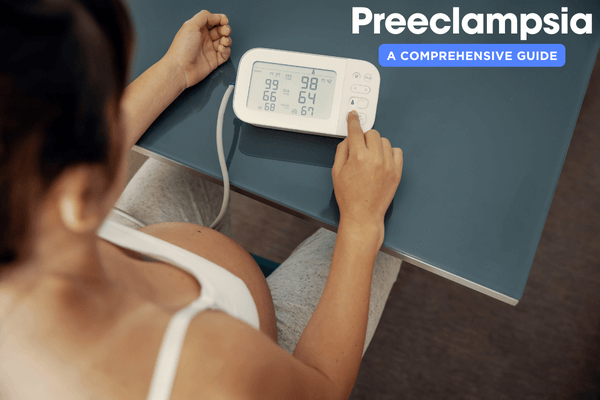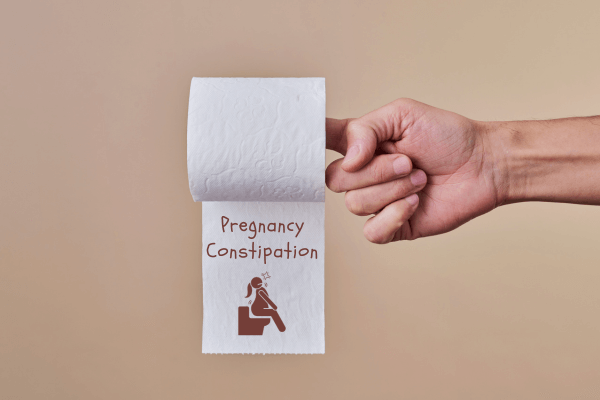Key Points
- Nature of Preeclampsia: A complex pregnancy complication characterized by high blood pressure and protein in urine, appearing in later stages or postpartum.
- Risk Factors: Includes genetic predisposition, age, obesity, pre-existing health conditions, and history of Preeclampsia.
- Symptoms: High blood pressure, protein in urine, swelling, headaches, vision problems, abdominal pain, and shortness of breath.
- Treatment and Management: Involves blood pressure medications, seizure prevention, close monitoring, and potentially delivering the baby early.
- Importance of Monitoring and Support: Emphasis on regular prenatal and postpartum check-ups, and the value of support networks and resources like Veira Life.
Preeclampsia is more than a mere complication of pregnancy; it’s a multifaceted condition that intertwines with the intricate biology of motherhood. Characterized by high blood pressure and often significant protein in the urine, Preeclampsia is a mysterious puzzle in maternal health. It poses considerable risks not just to the mother but also to the unborn baby, making understanding and managing this condition a critical aspect of prenatal care. In this detailed guide, we delve into the depths of Preeclampsia, exploring its nature, impact, and the nuances of its management. Our aim is to empower expectant mothers and families with knowledge, practical advice, and the latest insights into this condition.
What is Preeclampsia?
Preeclampsia is a multifaceted and often unpredictable condition in pregnancy, characterized by its sudden onset and complex nature.
- Occurrence: Typically, Preeclampsia makes its presence known after the 20th week of pregnancy, although it can surprisingly appear even after childbirth, known as postpartum Preeclampsia. Its development at this later stage can often catch new mothers and healthcare providers off guard, making postpartum monitoring equally important.
- Causes: The exact cause of Preeclampsia remains one of the great mysteries in obstetrics. However, it’s believed to result from a combination of several factors:
- Blood Vessel Issues: It’s thought that improper development or function of the placenta’s blood vessels plays a critical role. This may lead to reduced blood flow, contributing to high blood pressure and potential damage to organs.
- Immune Response: Some researchers suggest that an abnormal immune response to the placenta may trigger the condition, particularly in first-time pregnancies.
- Contributing Factors: Genetics can play a part, with a higher likelihood of Preeclampsia in women who have close relatives who have experienced the condition. Factors such as maternal age, obesity, and a history of certain health conditions (like hypertension or diabetes) can also increase the risk.
- Prevalence: Preeclampsia affects approximately 5-8% of all pregnancies globally. This rate, however, can vary based on geographic, demographic, and individual health factors. For instance, higher rates are often observed in developing countries, and certain lifestyle and health conditions can increase a woman’s risk.
Understanding Preeclampsia involves not only recognizing its symptoms and risk factors but also appreciating its unpredictability and the importance of regular prenatal care for early detection and management.
Other Risk Factors for Preeclampsia
- First-Time Pregnancy: Higher risk in the first pregnancy.
- Family History: Increased risk if close relatives had Preeclampsia.
- Age Factors: Higher risk for mothers under 20 or over 40.
- Multiple Pregnancy: Twins, triplets, or more increase the risk.
- Pre-Existing Medical Conditions: Such as hypertension, diabetes, kidney disease, or autoimmune disorders.
- Obesity: Higher body mass index (BMI) can elevate the risk.
- Previous Preeclampsia: Increased likelihood in subsequent pregnancies if experienced before.
- Time Gap Between Pregnancies: Short (less than 2 years) or long (more than 10 years) intervals between pregnancies may raise the risk.
- In Vitro Fertilization (IVF): Some studies suggest a higher risk in pregnancies achieved through IVF.
Symptoms to Watch For
Recognizing the symptoms of Preeclampsia is crucial for early detection and management. These symptoms can vary but typically include:
- High Blood Pressure: A reading of 140/90 mm Hg or higher is a primary indicator.
- Protein in Urine: Detected through urine tests, indicating potential kidney issues.
- Swelling (Edema): Unusual swelling in the hands, face, and around the eyes, distinct from normal pregnancy swelling.
- Headaches and Vision Changes: Severe, persistent headaches and vision issues like blurriness or seeing spots.
- Upper Abdominal Pain: Sharp pain under the ribs on the right side, suggesting liver involvement.
- Nausea or Vomiting: Particularly concerning if it starts later in pregnancy.
- Shortness of Breath: Can be a sign of fluid in the lungs, requiring immediate attention.
Regular prenatal visits are vital, as Preeclampsia can sometimes develop without noticeable symptoms. Any new or worsening symptoms should be discussed with a healthcare provider promptly.
Treatment Options for Preeclampsia
Treatment strategies for Preeclampsia are carefully tailored to the specific needs of each pregnancy, focusing on the stage and symptom severity:
Medications:
- Blood Pressure Control: Medications like labetalol, nifedipine, and methyldopa are commonly used to safely manage hypertension.
- Seizure Prevention: Magnesium sulfate may be prescribed to prevent eclampsia, a severe complication of Preeclampsia.
Corticosteroids:
- Used in severe cases, corticosteroids help improve liver function and increase platelet counts.
- They are also crucial for accelerating the development of the baby’s lungs in case of an early delivery.
Close Monitoring:
- Includes regular blood pressure checks, urine tests for protein, and blood tests for liver and kidney function.
- Frequent ultrasounds and fetal heart rate monitoring ensure the baby’s well-being.
- Hospitalization might be necessary for more severe cases where immediate medical intervention is needed.
Delivery:
- Often, delivering the baby is the definitive treatment for Preeclampsia, with the timing depending on the mother’s and baby’s health.
- This might involve inducing labor or, in some cases, a cesarean section, especially if urgent delivery is required.
Each treatment plan is unique and designed to ensure the best outcomes for both mother and baby.
Complications Arising from Preeclampsia:
Understanding the potential complications of Preeclampsia is crucial as they can have significant impacts on both the mother and the baby:
Maternal Risks:
- Eclampsia: A severe progression of Preeclampsia, leading to life-threatening seizures.
- Organ Damage: Particularly to the kidneys and liver, which can have long-term health implications.
- HELLP Syndrome: HELLP syndrome, an acronym for Hemolysis, Elevated Liver enzymes, and Low Platelet count, is a severe and potentially life-threatening complication during pregnancy, often regarded as a variant of preeclampsia. Early detection and intervention are crucial for both maternal and fetal well-being.
Fetal Concerns:
- Growth Restriction: Preeclampsia can affect the placenta, leading to inadequate nutrition and oxygen to the fetus, thus hindering growth.
- Preterm Birth: Often, early delivery is necessary to protect the health of the mother, which can result in premature birth of the baby.
- Placental Abruption: The condition may cause the placenta to detach from the uterus prematurely, a serious complication that can endanger both the mother and the baby.
Awareness and timely intervention are key to managing these complications effectively.
Also Read– What is a normal birth?
When to See a Doctor: Recognizing the Urgency
It’s essential for expectant and new mothers to understand when to seek medical attention in the context of Preeclampsia:
Regular Check-ups: Consistent prenatal visits are crucial for early detection and management of Preeclampsia. These appointments allow healthcare providers to monitor blood pressure and other vital signs, catching any early indicators of the condition.
Symptom Worsening: If any symptoms of Preeclampsia, such as severe headaches, changes in vision, intense abdominal pain, or sudden swelling, worsen or appear suddenly, it’s imperative to seek immediate medical attention. These symptoms can indicate a progression of the condition that may require urgent care.
Postpartum Monitoring: Postpartum Preeclampsia is a rare condition that comes from developing or continuing to have high blood pressure and excess protein in your urine after childbirth. New mothers should continue to monitor their health and consult their doctor if they experience symptoms of Preeclampsia post-delivery. This is particularly important in the first few weeks after giving birth.
Understanding these signs and maintaining regular communication with healthcare providers are key steps in ensuring both maternal and fetal health.
Also Read– Breastfeeding and Postpartum Depression
Community and Support for Preeclampsia
- Online Forums and Support Groups: Connecting with others who have experienced Preeclampsia for shared experiences, advice, and emotional support.
- Local Support Networks: Finding local groups, prenatal classes, or workshops focusing on Preeclampsia.
- Healthcare Team Collaboration: Working closely with doctors, nurses, and other healthcare professionals for comprehensive care.
- Maternity coaches: Finding a trusty coach who understands the condition and is professionally certified to guide you through your pregnancy and support you to manage the condition better
- Family and Friends Involvement: Engaging loved ones for emotional and practical support during and after pregnancy.
- Educational Resources: Utilizing books, websites, and informational brochures for additional knowledge and empowerment.
- Advocacy Groups: Joining or supporting organizations that advocate for Preeclampsia research and awareness.
Also Read– How to support your Pregnant Wife?
Conclusion: Empowerment in Managing Preeclampsia
Effectively handling Preeclampsia hinges on awareness, attentiveness to symptoms, and consistent dialogue with healthcare professionals. Proper care and vigilance enable most women to safely journey through their pregnancies. Knowledge is a vital ally in this process. It’s crucial to always seek tailored advice and care from healthcare experts to navigate this condition with confidence and safety.
Your Partner in Managing your Pregnancy - Veira Life
Navigating the complexities of Preeclampsia can be challenging, but you don’t have to do it alone. Veira Life is here to support you every step of the way. Our online prenatal classes, designed by experts and vetted by healthcare professionals, provide you with the resources and information you need to have a healthy Pregnancy.
With Veira Life, you gain access to a team of certified maternity coaches, including doulas and childbirth educators, who are committed to providing personalized support tailored to your unique needs during and after pregnancy.
Embrace your journey with confidence and the backing of a knowledgeable and compassionate community. Register with Veira Life today for comprehensive advice and support from pregnancy to postnatal care. Join us and become part of a nurturing community that’s ready to guide you every step of the way.
Also Read– What Is a Doula? | What is postnatal care?
References
FAQs
Early signs include high blood pressure, protein in urine, and swelling in hands and feet
Eclampsia, often following untreated Preeclampsia, is primarily caused by high blood pressure during pregnancy.
Preeclampsia resolves after delivery, but management is crucial during pregnancy for mother and baby’s health.
Risk factors include first-time pregnancy, family history, age extremes, obesity, and pre-existing conditions.
Prevention includes a healthy diet, regular exercise, weight management, and consistent prenatal care.







